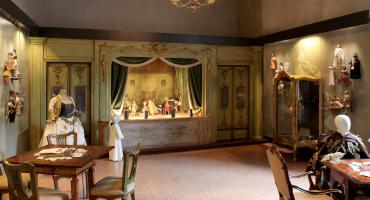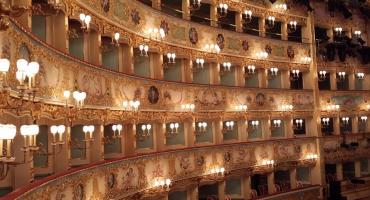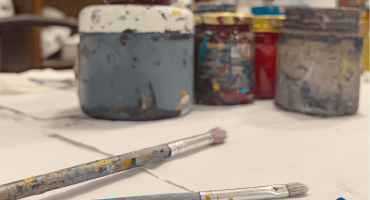Venetian masks were used to hide and protect the wearer's identity during promiscuous or decadent activities, but they became also the symbol of transgression and freedom from the severe social rules imposed by the Serenissima Republic.
 The original Venetian masks were rather simple in design and decoration and they often had a symbolic and practical function.
The original Venetian masks were rather simple in design and decoration and they often had a symbolic and practical function.
Masks were often used to protect gamblers from giving away indiscrete looks, especially to avoid their creditors, or by "barnaboti" noblemen who went bankrupt, begging on the corners of the street .
The history of masks
 The mask in the city of Venice has ancient origins and was used for many months of the year. Masks were allowed from the day after Christmas, which marked the beginning of the Venetian Carnival, to Shrove Tuesday which marked its end, but were forbidden during religious celebrations.
The mask in the city of Venice has ancient origins and was used for many months of the year. Masks were allowed from the day after Christmas, which marked the beginning of the Venetian Carnival, to Shrove Tuesday which marked its end, but were forbidden during religious celebrations.
As well as during the Carnival period, Venetians wore masks during the fortnight of the Ascension, and ended up wearing it, with a few exceptions, half-way through June. During all major events, such as official banquets or other celebrations of the Serenissima Republic, was permitted to wear a mask and a cloak.
 From the early 14th century, new restrictive laws started to be promulgated by the Venice Government, to stop the relentless moral decline of Venetian people.
From the early 14th century, new restrictive laws started to be promulgated by the Venice Government, to stop the relentless moral decline of Venetian people.
This carnival legislation proscribed masqueraders at night, forbade men from entering convents dressed as women to commit "multas inhonestates" and forbade masqueraders from carrying arms or entering churches.
To restore morality in Venice and avoid the incentive of immoral behavior of its citizens, the Serenissima Republic obliged them to wear a mask only during the days of Carnival and at official banquets only.
 Masks were produced for centuries in Venice and were made from papier-mâché, in many different colors and styles and decorated with fur, fabric, gems, or ribbons.
Masks were produced for centuries in Venice and were made from papier-mâché, in many different colors and styles and decorated with fur, fabric, gems, or ribbons.
The use of masks by both Venetians and foreign visitors during Carnival, created a great demand for masks and consequently contributed to the evolution of the figure of the mask-makers, registered artisans who created and sold masks in papier maché.
The traditional Venetian masks
 Between the most traditional Venetian costumes we find the bauta, a white mask covering almost the whole face, with a black cloak and a cocked hat. This mask was very popular in Venice and was worn both by men and women because it guaranteed total anonymity as it allowed the wearer to eat and drink without having to remove the mask.
Between the most traditional Venetian costumes we find the bauta, a white mask covering almost the whole face, with a black cloak and a cocked hat. This mask was very popular in Venice and was worn both by men and women because it guaranteed total anonymity as it allowed the wearer to eat and drink without having to remove the mask.
 Another traditional mask was the moretta, an oval mask of black velvet with a veil that was usually worn by women visiting convents and was attached to the woman's face thanks to a button held between the teeth.
Another traditional mask was the moretta, an oval mask of black velvet with a veil that was usually worn by women visiting convents and was attached to the woman's face thanks to a button held between the teeth.
 The Mattacino is another typical mask of Venice. He is a sort of clown, dressed in white or multicolored, famous for firing "perfumed eggs" from slingshots to the people who was passing in the street.
The Mattacino is another typical mask of Venice. He is a sort of clown, dressed in white or multicolored, famous for firing "perfumed eggs" from slingshots to the people who was passing in the street.
But the mask found its official consecration in the theatres: with the 16th century theatre, and later with the most famous Venetian playwright Carlo Goldoni, some of the most popular characters of the commedia dell'arte, the italian popular form of improvisational theater, also called "comedy of humors", became actual stereotypes, perfectly reflecting Venetian society.
Between the primary Commedia dell'Arte characters we find Pantalone, the rich and miserly merchant, Arlecchino, a funny peasant and illiterate character, acrobat and clown, always dressed with a colorful clothing, Colombina, the maidservant and eternal lover of Arlecchino, and Pulcinella, another comic servant character, as Arlecchino, typical of Naples.
 Nowadays Venetian masks re-emerged as the emblem of the Venice Carnival and most of them are made in gesso with a gold leaf and are all hand-painted or decorated with natural feathers and gems. During the modern Carnival Saint Mark's Square and the other main campi of Venice become the perfect stages for those who wish to be, at least for a few hours a year, protagonists of another life. In fact, during the last days of Carnival, Venice teems with people wearing all kind of masks and disguises, happily invading streets and squares in search of fun: it’s possible to meet every kind of costume, from the 18th century noblewomen, to the most inventive and creative personalised modern costumes.
Nowadays Venetian masks re-emerged as the emblem of the Venice Carnival and most of them are made in gesso with a gold leaf and are all hand-painted or decorated with natural feathers and gems. During the modern Carnival Saint Mark's Square and the other main campi of Venice become the perfect stages for those who wish to be, at least for a few hours a year, protagonists of another life. In fact, during the last days of Carnival, Venice teems with people wearing all kind of masks and disguises, happily invading streets and squares in search of fun: it’s possible to meet every kind of costume, from the 18th century noblewomen, to the most inventive and creative personalised modern costumes.



